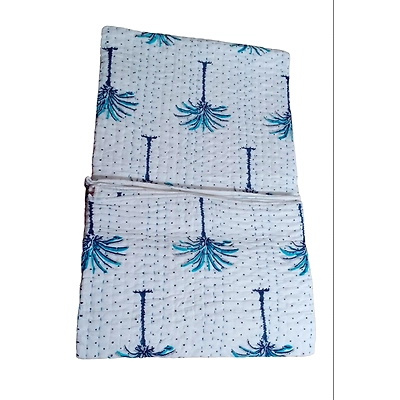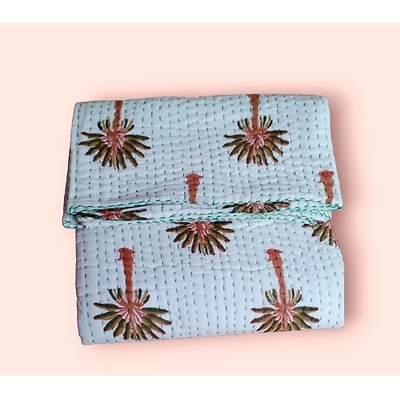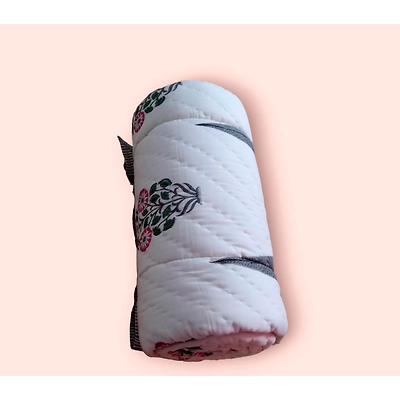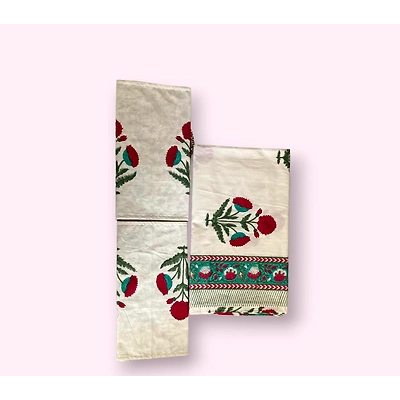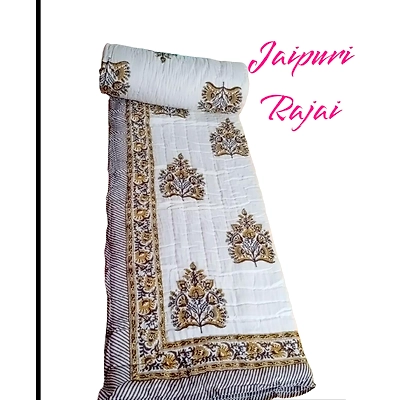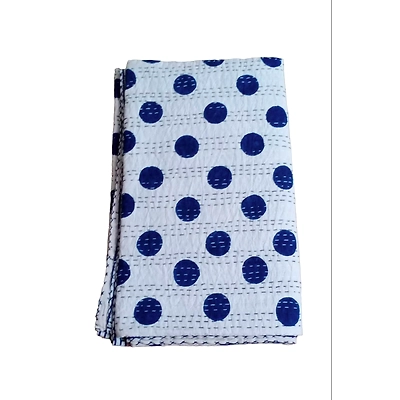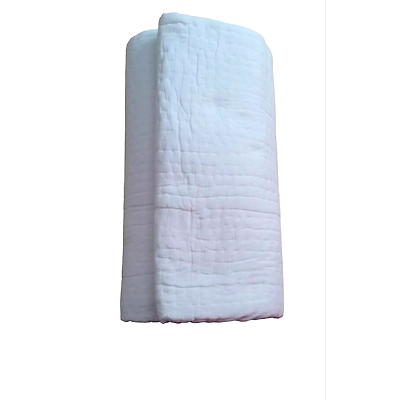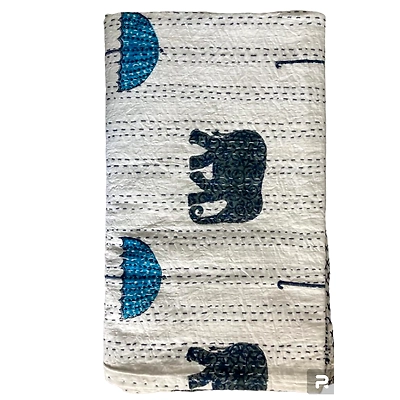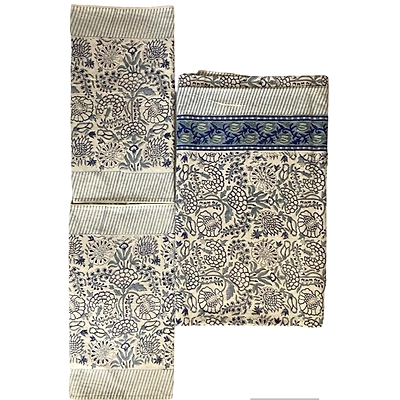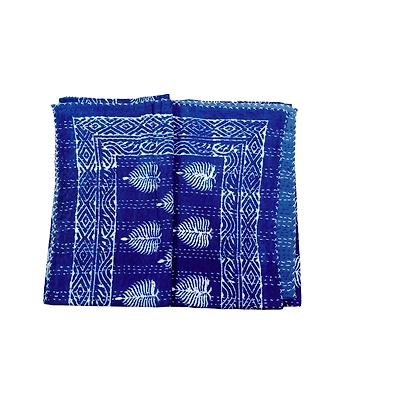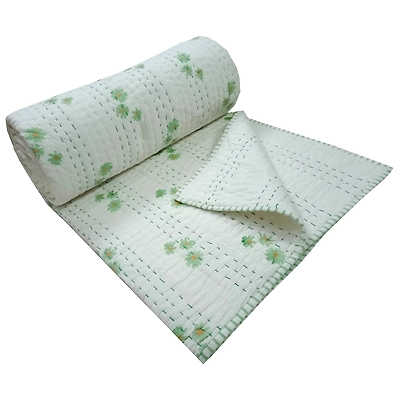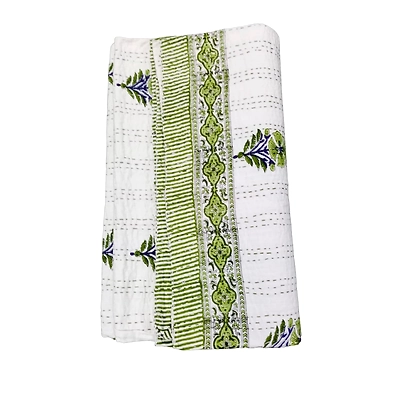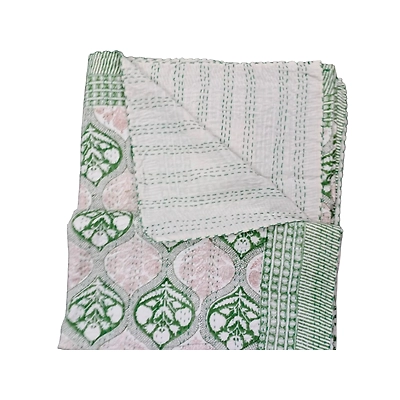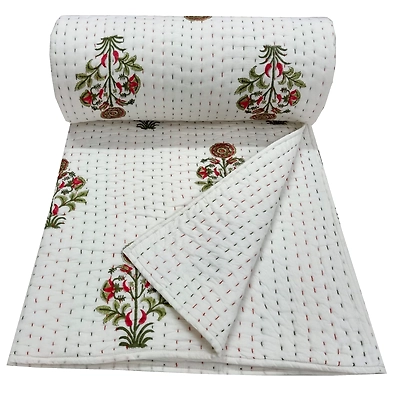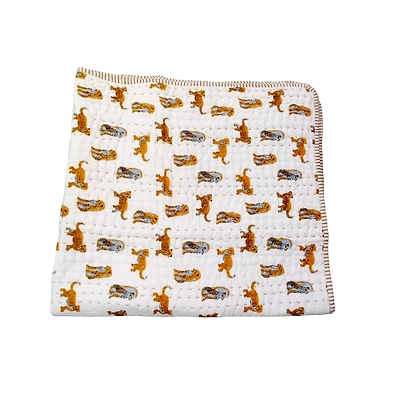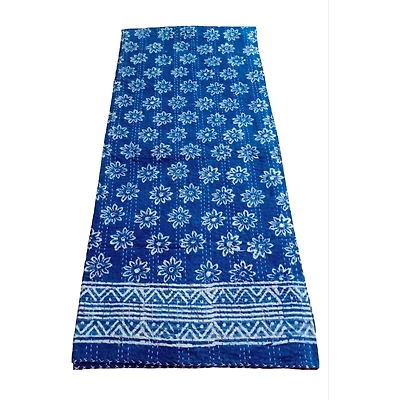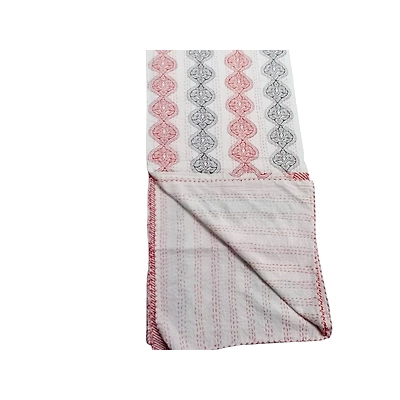Kanttha quilt
Rajasthani Kantha quilts are created by stitching together layers of old or discarded fabric using a simple running stitch. The fabric layers are typically made of cotton or silk and can include old saris, dhotis, or other garments. The running stitch used in Kantha quilting is known as "Kantha stitch," which gives these quilts their name.
The designs and motifs found on Rajasthani Kantha quilts reflect the cultural heritage and artistic traditions of Rajasthan. Common motifs include animals, birds, flowers, and geometric patterns. The artisans who create these quilts often draw inspiration from nature, folklore, and historical events.
The process of making a Rajasthani Kantha quilt involves several steps. First, the layers of fabric are stacked together, and the designs are drawn onto the top layer. Then, the layers are secured with small, even stitches using a needle and thread. The stitching not only holds the layers together but also creates intricate patterns and textures on the surface of the quilt.
Rajasthani Kantha quilts are known for their vibrant colours and intricate detailing. The artisans often use colourful threads to create contrasting patterns and textures. The stitching can be dense and closely spaced, or it can be more open, depending on the desired effect.
These quilts are not only decorative but also functional. They are used as bedspreads, blankets, or throws to provide warmth and comfort. Over time, Rajasthani Kantha quilts have gained recognition as valuable works of art and have become sought-after collector's items.
The production of Rajasthani Kantha quilts provides employment opportunities for many artisans, particularly women, who have inherited the craft from previous generations. It serves as a means of preserving traditional textile techniques and supporting local communities.
Kantha Quilt
Rajasthani Kantha quilts are created by stitching together layers of old or discarded fabric using a simple running stitch. The fabric layers are typically made of cotton or silk and can include old saris, dhotis, or other garments. The running stitch used in Kantha quilting is known as "Kantha stitch," which gives these quilts their name.
The designs and motifs found on Rajasthani Kantha quilts reflect the cultural heritage and artistic traditions of Rajasthan. Common motifs include animals, birds, flowers, and geometric patterns. The artisans who create these quilts often draw inspiration from nature, folklore, and historical events.
The process of making a Rajasthani Kantha quilt involves several steps. First, the layers of fabric are stacked together, and the designs are drawn onto the top layer. Then, the layers are secured with small, even stitches using a needle and thread. The stitching not only holds the layers together but also creates intricate patterns and textures on the surface of the quilt.
Rajasthani Kantha quilts are known for their vibrant colours and intricate detailing. The artisans often use colourful threads to create contrasting patterns and textures. The stitching can be dense and closely spaced, or it can be more open, depending on the desired effect.
These quilts are not only decorative but also functional. They are used as bedspreads, blankets, or throws to provide warmth and comfort. Over time, Rajasthani Kantha quilts have gained recognition as valuable works of art and have become sought-after collector's items.
The production of Rajasthani Kantha quilts provides employment opportunities for many artisans, particularly women, who have inherited the craft from previous generations. It serves as a means of preserving traditional textile techniques and supporting local communities.
Jaipuri Quilts
Jaipuri Rajai, also known as Jaipuri quilts or Jaipuri razai, are traditional handmade quilts that originate from Jaipur, a city in the Indian state of Rajasthan. These quilts have gained popularity not only in India but also worldwide for their vibrant colors, intricate designs, and exceptional craftsmanship.
Jaipuri Rajais are made using a unique quilting technique that involves layering and stitching together three separate layers of fabric. The top layer is typically crafted from soft and breathable cotton fabric, while the inner layer is made from warm and lightweight cotton filling known as "khadi." The bottom layer is usually a plain cotton fabric. The layers are meticulously stitched together using a series of small, straight stitches to ensure that the filling remains evenly distributed.
What distinguishes Jaipuri Rajais is their exquisite design and craftsmanship. Artisans in Jaipur employ various techniques such as block printing, hand embroidery, and tie-dyeing to create intricate patterns and motifs on the quilt's surface. These designs often draw inspiration from nature, traditional Rajasthani art, and cultural motifs. The use of vibrant colours, including bold reds, pinks, blues, and yellows, is another defining characteristic of Jaipuri Rajais.
Beyond their aesthetic appeal, Jaipuri Rajais are known for their functionality and comfort. The cotton fabric and filling make them lightweight, breathable, and suitable for both warm and cool climates. They provide warmth during colder seasons and keep cool during hotter months. The quilts are also durable and long-lasting, making them a practical investment.
Jaipuri Rajais have become sought-after home decor items, not only as bedspreads but also as decorative throws or wall hangings. They add a touch of traditional elegance and cultural richness to any living space. Additionally, the craftsmanship involved in creating Jaipuri Rajais supports local artisans and preserves the rich heritage of Rajasthan.
Bedsheet and Pillow cover
These Bedsheets and Pillow covers are created through a labour-intensive process involving skilled artisans. First, the fabric is typically made of pure cotton or silk, providing a soft and comfortable feel. Then, the fabric is hand-block printed using wooden blocks carved with intricate patterns. Natural vegetable dyes are often used to give vibrant colours to designs.
Sanganeri Kantha bed covers are known for their unique and eye-catching designs, which combine the art of block printing with the beauty of hand embroidery. They are often characterized by intricate patterns, vibrant colours, and fine detailing. This bed covers not only add a touch of elegance and charm to a bedroom but also represent the rich cultural heritage of Rajasthan.
Jaipuri Quilts
Jaipuri Rajai also known as Jaipur quilts or Jaipur razai are traditional handmade quilts that originate from Jaipur in the state of Rajasthan .these quilts have gained popularity not only in the Indian state of Rajasthan. theses quilts have gained popularity not only in India but also worldwide for their vibrant colours, intricate design, and exceptional craftsmanship
Jaipuri Rajais are made using a unique quilting technique that involves layering and stitching together three separate layers of fabric. The top layer is typically crafted from soft and breathable cotton fabric, while the inner layer is made from warm and lightweight cotton filling known as "khadi." The bottom layer is usually a plain cotton fabric. The layers are meticulously stitched together using a series of small, straight stitches to ensure that the filling remains evenly distributed.
.
Beyond their aesthetic appeal, Jaipuri Rajais are known for their functionality and comfort. The cotton fabric and filling make them lightweight, breathable, and suitable for both warm and cool climates. They provide warmth during colder seasons and keep cool during hotter months. The quilts are also durable and long-lasting, making them a practical investment.
Jaipuri Rajais have become sought-after home decor items, not only as bedspreads but also as decorative throws or wall hangings. They add a touch of traditional elegance and cultural richness to any living space. Additionally, the craftsmanship involved in creating Jaipuri Rajais supports local artisans and preserves the rich heritage of Rajasthan.
Hand Made Kantha Bed Cover
Rajasthani Kantha bed covers are created using layers of fabric, typically cotton or silk, stitched together using the kantha stitch. The layers of fabric can include old saris, dhotis, or other garments, which adds a unique character to each piece. The kantha stitch, a simple running stitch, is used to secure the layers of fabric and create intricate patterns and designs.
The designs found on Rajasthani Kantha bed covers are influenced by the artistic motifs and traditions of Rajasthan. They often feature elements such as animals, birds, flowers, and geometric patterns. The designs are meticulously stitched using colorful threads, creating vibrant and visually appealing compositions.
The process of making a Rajasthani Kantha bed cover involves the careful layering of fabrics and the skilled application of the Kantha stitch. Artisans draw inspiration from nature, folklore, and historical events to create unique and eye-catching designs. The stitching is done with precision, resulting in intricate patterns that add texture and depth to the bed cover.
Rajasthani Kantha bed covers are valued not only for their beauty but also for their functionality. They serve as decorative bedspreads, covers, or throws, providing warmth and comfort. The quilted layers of fabric offer insulation, making them suitable for use in different seasons.
The production of handmade Kantha bed covers in Rajasthan provides livelihood opportunities for artisans, especially women who have inherited the craft from previous generations. It helps preserve traditional textile techniques and supports local communities.
Hand Made Kantha Bed Cover
Rajasthani Kantha bed covers are created using layers of fabric, typically cotton or silk, stitched together using the kantha stitch. The layers of fabric can include old saris, dhotis, or other garments, which adds a unique character to each piece. The kantha stitch, a simple running stitch, is used to secure the layers of fabric and create intricate patterns and designs.
The designs found on Rajasthani Kantha bed covers are influenced by the artistic motifs and traditions of Rajasthan. They often feature elements such as animals, birds, flowers, and geometric patterns. The designs are meticulously stitched using colorful threads, creating vibrant and visually appealing compositions.
The process of making a Rajasthani Kantha bed cover involves the careful layering of fabrics and the skilled application of the kantha stitch. Artisans draw inspiration from nature, folklore, and historical events to create unique and eye-catching designs. The stitching is done with precision, resulting in intricate patterns that add texture and depth to the bed cover.
Rajasthani Kantha bed covers are valued not only for their beauty but also for their functionality. They serve as decorative bedspreads, covers, or throws, providing warmth and comfort. The quilted layers of fabric offer insulation, making them suitable for use in different seasons.
The production of handmade Kantha bed covers in Rajasthan provides livelihood opportunities for artisans, especially women who have inherited the craft from previous generations. It helps preserve traditional textile techniques and supports local communities.
Kantha Quilt
Rajasthani Kantha quilts are created by stitching together layers of old or discarded fabric using a simple running stitch. The fabric layers are typically made of cotton or silk and can include old saris, dhotis, or other garments. The running stitch used in Kantha quilting is known as "Kantha stitch," which gives these quilts their name.
The designs and motifs found on Rajasthani Kantha quilts reflect the cultural heritage and artistic traditions of Rajasthan. Common motifs include animals, birds, flowers, and geometric patterns. The artisans who create these quilts often draw inspiration from nature, folklore, and historical events.
The process of making a Rajasthani Kantha quilt involves several steps. First, the layers of fabric are stacked together, and the designs are drawn onto the top layer. Then, the layers are secured with small, even stitches using a needle and thread. The stitching not only holds the layers together but also creates intricate patterns and textures on the surface of the quilt.
Rajasthani Kantha quilts are known for their vibrant colours and intricate detailing. The artisans often use colourful threads to create contrasting patterns and textures. The stitching can be dense and closely spaced, or it can be more open, depending on the desired effect.
These quilts are not only decorative but also functional. They are used as bedspreads, blankets, or throws to provide warmth and comfort. Over time, Rajasthani Kantha quilts have gained recognition as valuable works of art and have become sought-after collector's items.
The production of Rajasthani Kantha quilts provides employment opportunities for many artisans, particularly women, who have inherited the craft from previous generations. It serves as a means of preserving traditional textile techniques and supporting local communities.
Hand Made Kantha Bed Cover
These Kantha Bed Cover names are HAND BLOCK PRINT Bed Covers. It is made by our rural women. Women are weaving this Bed Cover with their hands. These Bed Covers are a source of daily remuneration for rural areas women. This Bed Cover has been weaved at both sides. This Bed Cover is usually made by a group of 4 to 5 women. The Bed Cover making process takes 7 to 9 days. If you see these Bed Covers at this time I am sure that you have a unique thinking and standard maintenance level that separated you from this mob. Because In this time many people normally use ready-made products and you are among a few people who take an interest in these classic and vintage-type handmade Bed Covers. Believe us if you were making up your mind to buy it then you were one step closer to India's Vintage and Classic culture.
Bedsheet and Pillow cover
These Bedsheets and Pillow covers are created through a labour-intensive process involving skilled artisans. First, the fabric is typically made of pure cotton or silk, providing a soft and comfortable feel. Then, the fabric is hand-block printed using wooden blocks carved with intricate patterns. Natural vegetable dyes are often used to give vibrant colours to designs.
Sanganeri Kantha bed covers are known for their unique and eye-catching designs, which combine the art of block printing with the beauty of hand embroidery. They are often characterized by intricate patterns, vibrant colours, and fine detailing. This bed covers not only add a touch of elegance and charm to a bedroom but also represent the rich cultural heritage of Rajasthan.
HandMade Kantha Bed Cover
Rajasthani Kantha bed covers are created using layers of fabric, typically cotton or silk, stitched together using the Kantha stitch. The layers of fabric can include old saris, dhotis, or other garments, which adds a unique character to each piece. The Kantha stitch, a simple running stitch, is used to secure the layers of fabric and create intricate patterns and designs.
The designs found on Rajasthani Kantha bed covers are influenced by the artistic motifs and traditions of Rajasthan. They often feature elements such as animals, birds, flowers, and geometric patterns. The designs are meticulously stitched using colourful threads, creating vibrant and visually appealing compositions.
The process of making a Rajasthani Kantha bed cover involves the careful layering of fabrics and the skilled application of the Kantha stitch. Artisans draw inspiration from nature, folklore, and historical events to create unique and eye-catching designs. The stitching is done with precision, resulting in intricate patterns that add texture and depth to the bed cover.
Rajasthani Kantha bed covers are valued not only for their beauty but also for their functionality. They serve as decorative bedspreads, covers, or throws, providing warmth and comfort. The quilted layers of fabric offer insulation, making them suitable for use in different seasons.
The production of handmade Kantha bed covers in Rajasthan provides livelihood opportunities for artisans, especially women who have inherited the craft from previous generations. It helps preserve traditional textile techniques and supports local communities.
HandMade Kantha Bed Cover
Rajasthani Kantha bed covers are created using layers of fabric, typically cotton or silk, stitched together using the kantha stitch. The layers of fabric can include old saris, dhotis, or other garments, which adds a unique character to each piece. The kantha stitch, a simple running stitch, is used to secure the layers of fabric and create intricate patterns and designs.
The designs found on Rajasthani Kantha bed covers are influenced by the artistic motifs and traditions of Rajasthan. They often feature elements such as animals, birds, flowers, and geometric patterns. The designs are meticulously stitched using colorful threads, creating vibrant and visually appealing compositions.
The process of making a Rajasthani Kantha bed cover involves the careful layering of fabrics and the skilled application of the Kantha stitch. Artisans draw inspiration from nature, folklore, and historical events to create unique and eye-catching designs. The stitching is done with precision, resulting in intricate patterns that add texture and depth to the bed cover.
Rajasthani Kantha bed covers are valued not only for their beauty but also for their functionality. They serve as decorative bedspreads, covers, or throws, providing warmth and comfort. The quilted layers of fabric offer insulation, making them suitable for use in different seasons.
The production of handmade Kantha bed covers in Rajasthan provides livelihood opportunities for artisans, especially women who have inherited the craft from previous generations. It helps preserve traditional textile techniques and supports local communities.
HandMade Kantha Bed Cover
Rajasthani Kantha bed covers are created using layers of fabric, typically cotton or silk, stitched together using the kantha stitch. The layers of fabric can include old saris, dhotis, or other garments, which adds a unique character to each piece. The kantha stitch, a simple running stitch, is used to secure the layers of fabric and create intricate patterns and designs.
The designs found on Rajasthani Kantha bed covers are influenced by the artistic motifs and traditions of Rajasthan. They often feature elements such as animals, birds, flowers, and geometric patterns. The designs are meticulously stitched using colorful threads, creating vibrant and visually appealing compositions.
The process of making a Rajasthani Kantha bed cover involves the careful layering of fabrics and the skilled application of the Kantha stitch. Artisans draw inspiration from nature, folklore, and historical events to create unique and eye-catching designs. The stitching is done with precision, resulting in intricate patterns that add texture and depth to the bed cover.
Rajasthani Kantha bed covers are valued not only for their beauty but also for their functionality. They serve as decorative bedspreads, covers, or throws, providing warmth and comfort. The quilted layers of fabric offer insulation, making them suitable for use in different seasons.
The production of handmade Kantha bed covers in Rajasthan provides livelihood opportunities for artisans, especially women who have inherited the craft from previous generations. It helps preserve traditional textile techniques and supports local communities.
HandMade Kantha Bed Cover
Rajasthani Kantha bed covers are created using layers of fabric, typically cotton or silk, stitched together using the kantha stitch. The layers of fabric can include old saris, dhotis, or other garments, which adds a unique character to each piece. The kantha stitch, a simple running stitch, is used to secure the layers of fabric and create intricate patterns and designs.
The designs found on Rajasthani Kantha bed covers are influenced by the artistic motifs and traditions of Rajasthan. They often feature elements such as animals, birds, flowers, and geometric patterns. The designs are meticulously stitched using colorful threads, creating vibrant and visually appealing compositions.
The process of making a Rajasthani Kantha bed cover involves the careful layering of fabrics and the skilled application of the Kantha stitch. Artisans draw inspiration from nature, folklore, and historical events to create unique and eye-catching designs. The stitching is done with precision, resulting in intricate patterns that add texture and depth to the bed cover.
Rajasthani Kantha bed covers are valued not only for their beauty but also for their functionality. They serve as decorative bedspreads, covers, or throws, providing warmth and comfort. The quilted layers of fabric offer insulation, making them suitable for use in different seasons.
The production of handmade Kantha bed covers in Rajasthan provides livelihood opportunities for artisans, especially women who have inherited the craft from previous generations. It helps preserve traditional textile techniques and supports local communities.
Hand Made Kantha Bed Cover
Rajasthani Kantha bed covers are created using layers of fabric, typically cotton or silk, stitched together using the Kantha stitch. The layers of fabric can include old saris, dhotis, or other garments, which adds a unique character to each piece. The Kantha stitch, a simple running stitch, is used to secure the layers of fabric and create intricate patterns and designs.
The designs found on Rajasthani Kantha bed covers are influenced by the artistic motifs and traditions of Rajasthan. They often feature elements such as animals, birds, flowers, and geometric patterns. The designs are meticulously stitched using colourful threads, creating vibrant and visually appealing compositions.
The process of making a Rajasthani Kantha bed cover involves the careful layering of fabrics and the skilled application of the Kantha stitch. Artisans draw inspiration from nature, folklore, and historical events to create unique and eye-catching designs. The stitching is done with precision, resulting in intricate patterns that add texture and depth to the bed cover.
Rajasthani Kantha bed covers are valued not only for their beauty but also for their functionality. They serve as decorative bedspreads, covers, or throws, providing warmth and comfort. The quilted layers of fabric offer insulation, making them suitable for use in different seasons.
The production of handmade Kantha bed covers in Rajasthan provides livelihood opportunities for artisans, especially women who have inherited the craft from previous generations. It helps preserve traditional textile techniques and supports local communities.
Kids Handmade Quilt
This Kantha Baby Quilt's name is BLOCK PRINT Baby Quilt. It is made by our rural women. Women are weaving this Baby Quilt with their hands. These Baby Quilts are a source of daily remuneration for rural area women. This Baby Quilt has been weaved at both sides. This Baby Quilt is usually made by a group of 4 to 5 women. The Baby Quilt-making process takes 7 to 9 days. If you see these Baby Quilts at this time I am sure that you have a unique thinking and standard maintenance level that separates you from this mob. Because In this time many people normally use ready-made products and you are in a few people who take an interest in these classic and vintage-type handmade Baby Quilts. Believe us if you were making up your mind to buy it then you were one step closer to India's Vintage and Classic culture.
HandMade Kantha Bed Cover
Rajasthani Kantha bed covers are created using layers of fabric, typically cotton or silk, stitched together using the Kantha stitch. The layers of fabric can include old saris, dhotis, or other garments, which adds a unique character to each piece. The Kantha stitch, a simple running stitch, is used to secure the layers of fabric and create intricate patterns and designs.
The designs found on Rajasthani Kantha bed covers are influenced by the artistic motifs and traditions of Rajasthan. They often feature elements such as animals, birds, flowers, and geometric patterns. The designs are meticulously stitched using colourful threads, creating vibrant and visually appealing compositions.
The process of making a Rajasthani Kantha bed cover involves the careful layering of fabrics and the skilled application of the Kantha stitch. Artisans draw inspiration from nature, folklore, and historical events to create unique and eye-catching designs. The stitching is done with precision, resulting in intricate patterns that add texture and depth to the bed cover.
Rajasthani Kantha bed covers are valued not only for their beauty but also for their functionality. They serve as decorative bedspreads, covers, or throws, providing warmth and comfort. The quilted layers of fabric offer insulation, making them suitable for use in different seasons.
The production of handmade Kantha bed covers in Rajasthan provides livelihood opportunities for artisans, especially women who have inherited the craft from previous generations. It helps preserve traditional textile techniques and supports local communities.
HandMade Kantha Bed Cover
Rajasthani Kantha bed covers are created using layers of fabric, typically cotton or silk, stitched together using the kantha stitch. The layers of fabric can include old saris, dhotis, or other garments, which adds a unique character to each piece. The kantha stitch, a simple running stitch, is used to secure the layers of fabric and create intricate patterns and designs.
The designs found on Rajasthani Kantha bed covers are influenced by the artistic motifs and traditions of Rajasthan. They often feature elements such as animals, birds, flowers, and geometric patterns. The designs are meticulously stitched using colorful threads, creating vibrant and visually appealing compositions.
The process of making a Rajasthani Kantha bed cover involves the careful layering of fabrics and the skilled application of the Kantha stitch. Artisans draw inspiration from nature, folklore, and historical events to create unique and eye-catching designs. The stitching is done with precision, resulting in intricate patterns that add texture and depth to the bed cover.
Rajasthani Kantha bed covers are valued not only for their beauty but also for their functionality. They serve as decorative bedspreads, covers, or throws, providing warmth and comfort. The quilted layers of fabric offer insulation, making them suitable for use in different seasons.
The production of handmade Kantha bed covers in Rajasthan provides livelihood opportunities for artisans, especially women who have inherited the craft from previous generations. It helps preserve traditional textile techniques and supports local communities.
